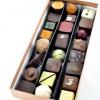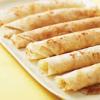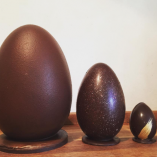-
Posts
18 -
Joined
-
Last visited
Contact Methods
-
Website URL
http://www.thechocdoc.co.uk
Profile Information
-
Location
Wiltshire, England, UK
Recent Profile Visitors
1,397 profile views
-
Hi all, Does anyone know how to glaze cakes like Gerald Sattler? See: In particular, the second video when it pans to the back large patisseries, where you get what I call a "giraffing" effect (!) - you can see this in some of his videos, he adds the normal chocolate mirror glaze, then adds other colours on a palette knife going forward then back to create the "swipe", but the colours repel each other. I suspect this is either due to more water in one than fat in the other or an alcohol base for the second colour (using titanium oxide as base white?), but I don't really have the time right now to try out all different combos! I saw one video in another language where they suggest the first glaze is at usual temp (say, 35oC) and then the second colour is at 65oC. I tried this with a white chocolate based glaze however I could not achieve the cool separation pattern so ended up doing some lateral swipes with my small pallete knife from it. Looks ok-ish but not happy: Would love to better know this technique - any thoughts or help appreciated! Thanks, TCD
-
Does anyone know exactly what this is and/or what you could substitute for it for in a recipe? There is a recipe it calls for that I wish to have a go at but do not want to buy it (plus hard to find a UK supplier of it!) if I can help. My understanding is it allows you to create a "false" ganache of sorts where humidity/moisture is an issue, for example if you want inclusions that would be affected by moisture in the ingredients (i.e. cream etc from a traditional ganache) you would add this instead and it would allow you to do so. I can only assume it must be fat based but is a chocolate like liquid from what I can tell (but I may be mistaken). Cocoa powder in an oil?!? Would be useful to know if anyone can tell me any info on it - cannot find much out. Many thanks, J
-
Made some chocopops recently and had an idea to put them like a flower arrangement (I've seen this with cake "pops" but not chocolates before, but I am sure I am not the first!). Seemed to work well and went down pretty well too at work! Also made some patisseries - mousse cakes, praline-chocolate and raspberry. Quite disappointed as I crushed the macarons (and they were 1 min away from being done ) but tasted good!
-
I've been dreaming of nougat for a few weeks now after the recent pictures - definitely a huge weakness of mine but a bad route for me to go down as a T1 diabetic...! I have just finished my 2013 version of "Chocoddity" - basically since last year I try to do this every year where I take 6 unique single origin chocolates and use them to make a ganache and dip the ganache with this chocolate. The ganache however is unusual or odd flavour combinations. I include a mini taster-bar with the chocolates to make it an experience - you taste the bar to get the flavours from the chocolate, then the dipped ganache and see how it fits together and complements (hopefully!). This year's effort I have gone quite extreme with the flavouring, a few really out there but feedback has been excellent thus far. From left to right: Goat's Cheese, Lemon & Beetroot (70% Dominican but white chocolate ganache) Single Reserve Maple Syrup & Earl Grey Tea (75% Tanzania) Coffee & Roasted Sesame (32% Java) Sansho Pepper & Cumin (67% Madagascar) Hibiscus & Tarragon (60% Grenada) Creme Fraiche & Lavender (39% Ecuador) The goat's cheese is an interesting one, the acid of the tartaric acid in the beetroot PDF with the sugar sweetness makes it taste more like blackcurrant (a la H Blumenthal) and that combo sounds odd but I love it. I really like the Sansho pepper & Cumin as the cumin to me is just slight, adds an earthy tone but the kicker is the Sansho pepper - severely delayed cold numbing heat on tongue that lingers for minutes after, but very subtley (Sansho is Japanese cousin of Szechuan and is underused in my opinion!). Hibiscus & Tarragon was a real winner especially as the tarragon just comes through very slightly with an ending of slight aniseed. However my favourite is Creme Fraiche & Lavender - could eat this all day long. You get a slight sour/acid from the creme acid which balances the sweetness of the milk chocolate, then very very subtle floral tone from the lavender late on. I do not like floral things but when they are just slight and only just noticeable (not over-powering), I think it works very well, personally. Was lots of fun and can't wait to come up with 6 new flavours for next year! Only 2 of the 6 original ideas I had I ended up modifying slightly (swapping flavours out). TDC
-
Wow. I don't normally venture out of the pastry forums but there are some stunning bits of food on display here! Its making me very hungry!! Although I stick more to the chocolatiering/patisserie/baking side of food, I recently promised my other half I would devise and cook her a 10-course tasting menu for her birthday. So this was my first attempt - some things really pleased with, some things not as happy with but all tasted good at least! Course 1: Gaspacho Granita Cacao Course 2: Baby Artichokes with pea puree & cumin foam Course 3: Sea Bass with White Chocolate & Dill Course 4: Sous vide pork belly with apple BBQ sauce & apple spaetzle Course 5:Venison with s Mushroom & Single Malt whisky sauce Course 6: Carpaccio of Beef Fillet with Fennel puree Course 7: Goat's cheese, Beetroot, Olive Tuile Course 8: Deconstruction of Lemon Meringue Course 9: Single plantation Peruvian Chocolate, Figs, Lavendar Honey Course 10: Inverted Affagato (I.e. espresso sorbet with warm vanilla sauce), Cardamom & Coconut Panna Cotta, White chocolate espuma I need to work on my presentation for sure but it was a long slog getting it all served out every 15 mins! Great fun though, recommend anyone to give it a go with good planning it can work! J
-
Hey everyone, long time no see - my day job has kept me manically busy lately, and away from chocolatiering much! Great to see so many lovely pieces of work - many very talented people here! Making me hungry too... I'm working on my new 6-flavour range for 2013, so hopefully can contribute some photos soon as well. Keep them coming!! J
-
Thanks very much Kerry, will be sure to check those out! I have family in PA so not too far from Washington and also my sister/brother-in-law/nephew are in Las Vegas on USAF base. Am looking forward to my Vancouver conference as I've never been to Canada in my adult life (was 2 yrs old when my parents took me to Niagra!!). TCD
-
I think because you have a pure invert sugar you will use, it is very different to heating sucrose to caramel, which will form caramel obviously (and long enough become very bitter and burnt). Fructose+Glucose in pure 50/50 form (invert) will become more bitter easily and no longer (due to degradation and reactions) have their beneficial properites of keeping water around to stop crystallisation and keep a smooth, soft centre so you lose those beneficial properties. I guess you could try yourself and boil up some invert and taste it and see! TCD
-
It is something I find very common - but then again chocolate making (from bean to bar, and bar to hand-made delights) is a VERY scientific process! So it shouldn't be a huge surprise I guess that a lot of scientists end up in chocolate one way or another. Plus the stress of research often lends itself towards overeating of chocolate anyway.... I wish I was able to hop over to Canada in April! I'm actually in Vancouver on an International Cancer conference the end of Jan/beginning of Feb and will no doubt try to seek out some chocolatier shops on my visit! However living in the UK and the arrival of a little one anytime in the next 2-3 weeks means I probably wouldn't be able to afford the costs (or time off work!) to get over to Canada from the UK for April unfortunately!! Shame! What part of Canada are you from? TCD
-
Invert is quite sweet, so you can opt for other humectants such as glucose syrup which will be less so, but most chocolatiers seem to go for the higher percentage syrups. Eg. Greweling recommends between 25-30% weight of cream as glucose syrup. Eg with 2:1 you would have say 200g cream, 400g dark chocolate, 50-60g glucose syrup. If you look at William Curley's truffle recipes they are more like 14% invert of cream, HOWEVER the cream is almost at a 1:1 ratio with the chocolate (and whipping not heavy/double cream so more water yet to dilute the cacao). So if you were to take his standard truffle ganache it is 435ml/g whipping:500g choc:60g invert (+75g butter) so you have to account for a very different cream volume diluting the chocolate more than Greweling's. If you look at Paul Young it is even more sweet (by the way he just won several GOLDS at the International/World chocolate awards which they only give one out per category, so must be doing something right!). His receipe for basic truffle ganache is 250g choc, 250g cream, 100g muscavado sugar. That is 20% sugar of entire combo weight of cream & choc!! Then look at Michael Recchiuti - his Earl Grey recipe has 8oz heavy cream - 4oz invert sugar - 9 oz chocolate (65%). Others still will advocate no humectant and just cream and chocolate. The point is really even among the top professionals there is huge variation. It will also depend if you are doing a standard ganache or a flavoured one (eg. the earl grey may need more sweetness however even to me 50% weight of cream being invert seem excessive personally!). You can often be surprised how little sweetness is translated from increasing the invert/glucose from 10 to say 20% - when working with dark chocolate in particular this isn't as dramatic as it sounds to most people in terms of taste in my personal opinion. You must also consider if you go down the Greweling et al route of a milk becomes more like 1:2.5 then automatically the overall percentage of sugar is reduced as you have a lower amount of cream and so the humectant also reduces (eg. to compare to above recipe with 400g chocolate it becomes 160g cream and 40g humectant for 25%). With shelf life I think it is often forgotten that this should not only reflect the microbial aspect (i.e. safety to eat and no spoilage), but additionally the taste/flavour aspect of shelf life. For example, in my personal experience I find a lot of tea ganaches have a shortened shelf life as the flavour fades much more rapidly than say my rosemary ganache. I even switched to having my tea ganaches kept in an airtight box with a muslin inside that had the tea leaves within it, as so to create a microenvironment that inhibited the loss of the tea flavour from the ganache (despite being dipped in tempered chocolate properly!). However my tea ganache lasts a good 2+ months no problems, but I would say from 3 weeks onwards the taste is significantly less superior than at the 1-2 week stage. Finally, with regards to ratios and how much cream etc etc relating to Aw, I think often people like Greweling have to assume a level of responsibility in that many people who try to make these may not have the best sterile-like conditions combined with good understanding of tempering the ganache for stability (and shelf life), not just tempering the chocolate. Thus it is often the case to err on the side of caution about shelf life. If you look at Wybauw and many of his recipes, and the correlating Aw you can see that often the Aw can be quite decent even with a considerable amount of cream. Eg: 80g Black tea 2500g whipping cream 600g invert 600g butter 60g orange blossom water 3000g milk chocolate (for moulded - 4000g if slabbed) That puts you at about a 24% weight of cream for the invert, but the cream is at over 83% of the chocolate weight!! There is a fair amount of butter to make up the fat to a high amount however the main point is despite the high amounts of cream compared to the milk chocolate, the Aw stated is 0.808 which would give it up to 3 month shelf life (as < 0.85). I've made this recipe (slabbed version) and modified it for my own needs however the original recipe does hold well for at least 8-10 weeks in terms of spoilage if you work with good technique (clean/aseptic as possible) and follow the tempering of the ganache well. It does however suffer from a loss of flavour over time though that for me, would put it at the 4 week shelf life purely on taste. The curley's and young's of the world though like the higher cream:chocolate ratio's generally end up with 2-3 week shelf life max, ESPECIALLY because people like Curley do not advocate tempering their ganache, and furthermore in his recipes, Curley will advocate boiling the cream with invert, which is a no-no as invert should not go above 70degC for shelf life and taste reasons. Unless you have access to a hygrometer to determine Aw, you either have to follow recipes well that have established Aw values or do what has already been mentioned and to testings. The only hard thing about this is saving 1 of your chocolates to taste test every week and not eating them all up in 2-3 weeks! TCD
-
Hi Kerry, thanks for the comments. My business is not as active as I'd like but I only do this part time. I've always had a love for baking and cooking and about 3 years ago I became interested in chocolates and so bought a few books, a few moulds, couverature, and never looked back. Last year I developed my own Signature range of 24 flavours of ganaches and was prepared to try it full time as I was being made redundant from my job (was a scientific researcher funded by cancer research UK). I was lucky enough to finally get a job with a company that makes cancer drugs though 1 month after I was made redundant, which is what I'd always wanted to get into so instead of sticking to full time chocolatiering I chose to take a salaried job and put chocolate back as a hobby. Bit too risky to turn down a salaried position when my chocolatiering skills are completely self taught and I have no training in food of any sort except trial and error (lots of that!). This year I was close to giving it up due to a nightmare relocation and other issues, but I had submitted a few chocolates to some National food awards here in UK (Great Taste Awards 2012) to get feedback from the professionals, and to my surprise 2 of the 4 I submitted received Gold star awards. For example my Sea Salted Caramel won the Gold one-star award, the same award Hotel Chocolat won for their equivalent chocolate. That led me to think maybe I should keep developing some things for fun - I enjoy it very much just limited by time and as such, do not ever push my business nor do I make any profit from it all! Just love making interesting flavours and nice looking chocs when I can. Love seeing what other people get up to as well! So it is great to see what others get up to on these forums! TCD
-
I love my frog moulds! I make "Caramel Poisonous Frogs" and kids love them! Eggs are also fun to try different decorations - my first Easter as a chocolatier when I started selling I played around quite a bit, had 7 different decorations I think, 3 here (gianduja egg, sea-salted caramel egg and chili egg): Long way to go to reach show room standard but its all good fun! TCD
-
I feel for you Coreen, there is nothing worse as a chocolatier when the temper tantrums start for no good reason. Happens to us all... Look also at room temperature and humidity. Humidity is often underlooked. For moulds if you are using decent dark chocolate it shouldn't be going out of temper if the chocolate is between 29degC-34degC really. If it tempers WELL and correctly initially, it can go 1-2deg below and above optimum without losing temp and giving bloom. But not above 34oC (sorry, metric here! whatever than is in F). I would also look into how you seed - I know nothing of these machines as do most by hand but for dipping slabbed ganaches I sometimes use my chocovision just as easier to dip. However if the temp is off and you remove seed too early (i.e. you think it has gone below 34 but it hasn't) then it won't be in temper. Personally though the easiest method I find is cocoa butter seeding. So simple and straightforward - never have a problem with this method (although sometimes avoid if chocolate is already quite fluid). For ladle if you are concerned about affecting the temp (it shouldn't) you can always heat gun/hair dryer your ladle first and use an infa-red thermometer (or hand test) to see that it is not too hot - aim for hair drying to just below the temp of the chocolate. Obviously if you go too high (>34degC) you will untemper your chocolate. TCD
-
Panaderie - Thanks for your comments - I have tried Arriba and it is very good - I can source some of those origin beans certainly in milk and I think in dark too. Ecuador is on next year's origins collection I hope to do! sunshine-supernova - thanks! Yep, I painted a square on the mini-bar mould with a colour, let it set then add the tempered choc as usual. Was in a hurry with most of them as this is development so not all were as neat as they could be (esp the sea-salted chili caramel moulded ganache!!). TCD
-
If your Aw is below 0.85 then you can generally (assuming good technique and stable formulation) assume a maximum shelf life of 3 months. Using a 2:1 ratio for a ganache with at least 25% humuctant (eg. glucose, invert, corn syrup etc) to cream amount you can get mostly under 0.85 Aw. With addition of other things such as Sorbitol you can improve shelf life. I would recommend that you get Wybauw's 3rd book on extending shelf life if you want to further understand alcohol's contribution. It all will come down to the % alcohol content you end up with - because remember, alcohol is usually water based and so adding water also reduces (dramatically) shelf life of a ganache/product in general, and so this has to be balanced with the overal alcoholic content that the dilution will give. By the way - if you are looking for a real raspberry punch then IMO the best way to do this is to add crushed (i.e. powdered) freeze-dried raspberries. My buttercreams for raspberry flavour that clients have asked for (wedding cakes) I always make with butter icing sugar (1:1) with some vanilla, then raspberry puree with white chocolate (tempered thin ganache) incorporated and a tbsp or 2 of powdered freeze-dried raspberry. That gives it a very intense powerful raspberry flavour and also helps keep it firm and extend shelf life (as less water). Good luck! TCD






